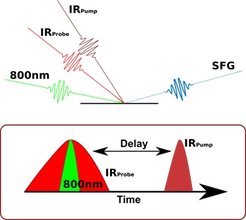Methods | E. Backus
Sum Frequency Generation Spectroscopy at Interfaces

In order to study the chemical characteristics of an interface, one needs a method which is “interface-specific”. Since at the interface, there are only a handful of molecules available which are outnumbered by the molecules at the bulk, one needs to filter out/ suppress the signal coming from the molecules in the bulk and simultaneously amplify the “responses” of the handful of molecules at the interface. This can be achieved with the laser based technique, Sum Frequency Generation (SFG) Spectroscopy. It is an advanced form of IR spectroscopy in which the sample is irradiated with a pair of spatio-temporally overlapped IR and 800 nm beams. The IR beam is in resonance with a molecular vibration of the molecules in the sample under investigation and excites part of the molecules into a higher vibrational state to create an excited-state-population. This population is further up-converted by the 800 nm beam. Subsequently, light at the sum frequency of the incoming IR and 800 nm light is emitted.
Information about vibrational dynamics of the interfacial molecules can be obtained by slightly modifying the method into a time resolved version. The oscillators are first impinged with a narrow-band IR pump pulse which is also in resonance with the oscillators. Therefore, it "burns a hole" in the ground state population. Subsequently the oscillators are irradiated with the probe pair consisting of IR and 800 nm light to quantify the "depth of the hole" in the ground state. By changing the time between the pump and probe pair, the recovery of this "hole" as a function of time can be quantified. This timescale provides information on the vibrational lifetime.

Subsequently, a 2D-SFG spectrum could be obtained by varying the pump frequency. In this way a 2 dimensional map of "holes" at different "probe" frequencies as function of "pump" frequencies can be obtained. In case ensemble of molecules form sub-ensembles which differ in their physio-chemical nature cross peaks could be observed in the 2D-SFG spectrum. The timescale of the appearance of the cross peaks provides information about the entanglement of the sub-ensembles.

